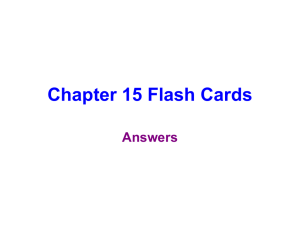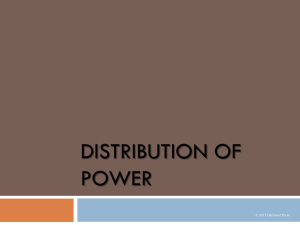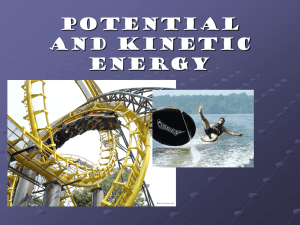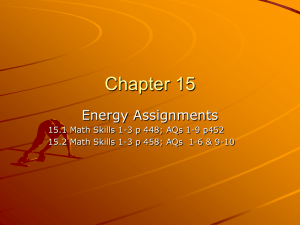Lieb-Liniger, Tonks-Girardeau and super Tonks
advertisement
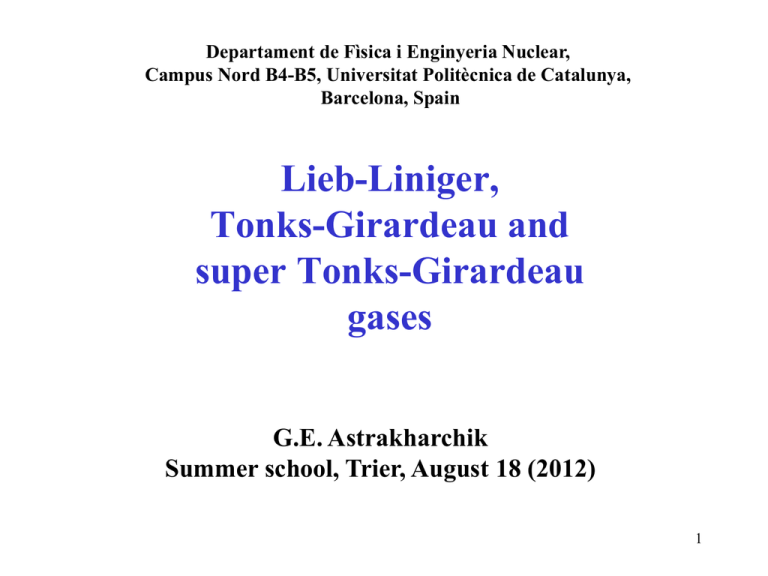
Departament de Fìsica i Enginyeria Nuclear, Campus Nord B4-B5, Universitat Politècnica de Catalunya, Barcelona, Spain Lieb-Liniger, Tonks-Girardeau and super Tonks-Girardeau gases G.E. Astrakharchik Summer school, Trier, August 18 (2012) 1 CONTENTS • Introduction • Why low-dimensional systems are special? • Density scaling: potential vs kinetic energy • Lieb-Liniger gas • Energy expansion in Bogoliubov theory • Tonks-Girardreu gas • Unitary gas • Super Tonks-Girardeau gas • Dynamic form factor • Conclusions ONE-DIMENSIONAL QUANTUM WIRES • One-dimensional quantum systems have been experimentally realized and studied already in 80's in GaAs/AlGaAs semiconductor structures. • Systems with free electrons confined to one dimension (quantum wires) has been realized. • Conductance properties, elementary excitations, etc have been measured. Figure with dispersion of excitations in a quantum wire taken from 1991 3 experiment by A. R. Goñi et al. in AT&T Bell Laboratories, New Jersey 1D BOSE GAS IN A MICROCHIP • Atoms can be confined to onedimensional geometry • heavier and larger • easier to detect • can be bosons or fermions • microchip experiments: cold atoms trapped in a combination of two magnetic fields: external magnetic field and field generated by an electric current in wire. taken from “BEC on a microchip”, 4 J. Reichel et al. MPI, München COLD GASES IN OPTICAL LATTICES Advanced and unique features of dilute ultracold gas experiments with optical lattices: • Possibility to fine-tune the interaction strength by using Feshbach resonances - contrary interactions between electrons in a quantum wire can be hardly changed • highly controllable geometry of the confinement parameters - for example spacing and height of an optical lattice - can be changed dynamically • extremely pure systems - no defects as in quantum wires - no condensate fragmentation as might happen in micro chip 5 traps CONDITION FOR ONE-DIMENSIONALITY The gas behaves dynamically as onedimensional when the excitations of the levels of the transverse confinement are not possible: • Condition for the energy • Condition for the temperature Figure is taken from T.Esslinger et al./Zurich Comparison of the frequencies of the dipole and breathing modes confirms the achievement of the 6 quasi-one-dimensional regime. CONTENTS • Introduction • Why low-dimensional systems are special? • Density scaling: potential vs kinetic energy • Lieb-Liniger gas • Energy expansion in Bogoliubov theory • Tonks-Girardreu gas • Unitary gas • Super Tonks-Girardeau gas • Dynamic form factor • Conclusions WHY LOW-DIMENSIONAL SYSTEMS ARE SPECIAL? From theoretical point of view low-D systems are interesting as: • The role of quantum effects is increased as the dimensionality is lowered. • In particular, in one dimension, quantum fluctuations destroy - crystalline order (no solid in 1D) - Bose-Einstein condensation (no BEC in 1D) • Quantum statitstics are topologically interconnected - Bose-Fermi mapping from Tonks-Girardeau gas to an ideal Fermi gas. • There is a number of exactly-solvable many-body Hamiltonians • Integrability in Hamiltonian might lead to absence of thermalization, as shown in recent experiments 8 EXACTLY SOLVABLE 1D MODELS 9 CONTENTS • Introduction • Why low-dimensional systems are special? • Density scaling: potential vs kinetic energy • Lieb-Liniger gas • Energy expansion in Bogoliubov theory • Tonks-Girardreu gas • Unitary gas • Super Tonks-Girardeau gas • Dynamic form factor • Conclusions POTENTIAL ENERGY: TYPICAL SCALING WITH DENSITY 1.0 (r) 0.5 0.0 0.0 0.5 r/l 1.0 11 KINETIC ENERGY: TYPICAL SCALING WITH DENSITY 12 POTENTIAL vs KINETIC ENERGY 2 E/N 10 1 10 kinetic energy potential energy 1D 2D 3D 0 10 -1 D 10 1 , D 3 -2 10 -2 10 na 2D -1 10 0 10 1 10 D 2 10 13 THREE-DIMENSIONAL GEOMETRY 2 E/N 10 1 10 kinetic energy potential energy 0 10 -1 10 na -2 10 -2 10 -1 10 0 10 1 10 3 2 10 14 TWO-DIMENSIONAL GEOMETRY 2 E/N 10 1 10 kinetic energy potential energy 0 10 -1 10 na -2 10 -2 10 -1 10 0 10 1 10 2 2 10 15 ONE-DIMENSIONAL GEOMETRY 2 E/N 10 1 10 kinetic energy potential energy 0 10 -1 10 na -2 10 -2 10 -1 10 0 10 1 10 2 10 16 MEAN-FIELD vs QUANTUM REGIMES 17 CONTENTS • Introduction • Why low-dimensional systems are special? • Density scaling: potential vs kinetic energy • Lieb-Liniger gas • Energy expansion in Bogoliubov theory • Tonks-Girardreu gas • Unitary gas • Super Tonks-Girardeau gas • Dynamic form factor • Conclusions LIEB-LINIGER HAMILTONIAN N bosonic particles of mass m interacting with contact δ-function pseudopotential in a one dimensional system are described by the Lieb-Liniger Hamiltonian: The effective quasi-one-dimensional coupling constant is inversely proportional to the one-dimensional s-wave scattering length The model solved exactly by E. H. Lieb and W. Liniger in (1963) Phys. Rev. 130, 1605 (1963) Elliott H. Lieb 19 BETHE-ANSATZ SOLUTION 20 ENERGY OF LIEB-LINIGER GAS E/N 4 10 3 10 2 10 1 10 0 10 -1 10 -2 10 -3 10 Lieb-Liniger gas Gross-Pitaevskii gas Tonks-Girardeau gas -4 10 -5 10 -6 10 -3 10 -2 10 -1 10 0 10 1 10 2 10 3 10 n1D |a1D| 21 CORRELATION FUNCTIONS 22 ANALYTIC RESUTLS LIEB-LINIGER GAS (arbitrary value of n|a1D|). Many properties of the system can be obtained from the Bethe ansatz. 1) The ground-state energy / N = e(n|a1D|) 2n2 / 2m [Lieb, Liniger Phys. Rev. 130, 1605 (1963)] 2) The expansion of the OBDM g1(z) at zero g1(z) = 1 - 1/2 (e + (n|a1D|) e’(n|a1D|)) |nz|2 + e’(n|a1D|)/6 |nz|3 [Olshanii, Dunjko PRL. 91, 090401 (2003)] 3) The value of the pair distribution function g2(z) at zero g2(0) = - (n|a1D|) e’(n|a1D|) /2 [Gangardt, Shlyapnikov PRL 90, 010401 (2003)] 4) Relation between short-distance(2-body) physics and equation of state for δ-interaction: analog of Tan’s contact M. Barth, W. Zwerger (2011) 5) Large-range asymptotic g1(z) are predicted from hydrodynamic theory [Haldane PRL 47, 1840 (1981)] g1(z) = C / |n z|α with the coefficient α= 23 mc / 2πn = c / 2cF related to the speed of sound mc2 = μ / n PAIR DISTRIBUTION FUNCTION Pair distribution function function for different values of the gas parameter. Arrows indicate the value of g2(0) as obtained from the equation of state. At24 n|a1D|=10-3 the g2(z) function is similar to the one of the a Tonks-Girardeau gas. LOCAL PAIR CORRELATION FUNCTION 25 ONE-BODY DENSITY MATRIX One-body density matrix g1(z) (solid lines), power-law fits (dashed lines). The long-range asymptotic value of OBDM gives the condensate fraction. • i.e. condensate is absent in all cases. 26 TRAPPED TG GAS: EXPERIMENTS 27 ENERGY EXPANSION In the mean-field description the chemical potential is linear with the density: Beyond mean-field terms can be found perturbatively within Bogliubov theory. • for 3D Bose gas the correction was found by K.W. Huang and Nobel prize winners C. N. Yang and T. D. Lee. • for 1D Bose gas the correction can be found from Bogoliubov theory and it coincides with expansion of the Bethe ansatz result: 28 This coincidence is not trivial as condensate fraction is zero! THREE-BODY CORRELATION FUNCTION DEFINITION The three-body correlation function (its value at zero) is defined as N ( N 1)( N 2 ) | 0 ( 0 , 0 , 0 , z 4 ,.., z N ) | dz 4 .. dz N 2 g 3 (0) 1 n 3 ˆ ( z ) ˆ ( z ) ˆ ( z ) ˆ ( z ) ˆ ( z ) ˆ ( z ) n 3 | 2 0 ( z1 ,.., z N ) | dz 1 .. dz N This function is related to the probability of three-body collisions LIMITING EXPRESSIONS 1) In the Tonks-Girardeau regime (n|a1D| 1) the three-body collisions are highly suppressed 6 g 3 (0) ( n a 1 D ) 60 2) In the limit of weakly interacting gas (Bogoliubov theory), (n|a1D| 1) g 3 (0) 1 6 2 na 1 D 3) Approximation (arbitrary density n|a1D|) g 3 ( 0 ) ( g 2 ( 0 )) 3 29 THREE-BODY CORRELATION FUNCTION Value at zero of the three-body correlation function g3(0) (black squares) on the log-log scale, TG limit (blue dashed line), Bogoliubov limit (red dashed line), 30 3 (g2(0)) (solid black line), experimental result of Tolra et al.’04 (green diamond). THREE-BODY CORRELATION FUNCTION Value at zero of the three-body correlation function g3(0) on the log-log scale, as a function of γ). Solid line V.V. Cheianov et al, JSTAT 8, P08015. (2006). 31 Experimental data: H.-C. Nägerl group, PRL 107, 230404 (2011). STATIC STRUCTURE FACTOR: LIEB LINIGER 1.0 S (k ) 10 3 30 0.8 1 0.3 0.6 10 -3 0.4 0.2 0.0 0 2 4 6 8 10 k / n1D Static structure factor S(k) for different values of the gas parameter (solid lines). The dashed lines are the corresponding long-wavelength asymptotics.At n|a321D|=10-3 the static structure factor is similar to the one of the a Tonks-Girardeau gas. CONTENTS • Introduction • Why low-dimensional systems are special? • Density scaling: potential vs kinetic energy • Lieb-Liniger gas • Energy expansion in Bogolubov theory • Tonks-Girardreu gas • Unitary gas • Super Tonks-Girardeau gas • Dynamic form factor • Conclusions TONKS-GIRARDEAU GAS 34 BOSE-EINSTEIN STATISTICS 35 FERMI-DIRAC STATISTICS 36 ONE-DIMENSIONAL FERMI GAS 37 MAPPING OF THE WAVE FUNCTION 38 TONKS-GIRARDEAU GAS: WF 39 TG GAS: PDF and STATIC STRUCTURE FACTOR 1.0 1.0 g2 Sk 2 n 0.5 0.0 0.5 0 1 2 nz 3 0.0 0 1 2 3 k / kF 4 40 TG GAS: MOMENTUM DISTRIBUTION 3 nk fermions (ideal Fermi gas) bosons (Tonks-Girardeau gas) 2 1 0 0 1 2 k / kF 3 41 CONTENTS • Introduction • Why low-dimensional systems are special? • Density scaling: potential vs kinetic energy • Lieb-Liniger gas • Energy expansion in Bogolubov theory • Tonks-Girardreu gas • Unitary gas • Super Tonks-Girardeau gas • Dynamic form factor • Conclusions UNITARY AND TG GASES: 3D 43 UNITARY AND TG GASES: BOSONS IN 3D 44 UNITARY AND TG GASES: BOSONS IN 1D 2 E/N 10 1 10 kinetic energy potential energy 1D 2D 3D 0 10 -1 1D , 3D 2D 10 -2 10 -2 10 -1 10 na 0 10 1 10 D 2 10 45 GOING BEYOND TONKS-GIRARDEAU LIMIT 1 .0 0 .8 g (z ) m e an f ie ld G ro s s- P ita e vs k ii 2 na 0 .6 na 1D 1D =10 -3 = 0 .3 n a1 D=1 0 .4 na na 0 .2 1D 1D =30 = 1 00 To n k s- G ira rd e au 0 .0 0 1 2 3 4 5 n z 46 TWO-BODY SCATTERING SOLUTION (x) 1.0 0.8 0.6 Tonks-Girardeau g1D + 0.4 0.2 super Tonks-Girardeau g1D < 0 0.0 -0.2 -0.4 a1D < 0 -0.1 hard rods a1D > 0 0.0 0.1 0.2 0.3 0.4 0.5 x, [a.u.] 47 6 4 0 a1D MF -GP 2 resonance TG, g1D /(aoscosc); a1D / aosc 8 g1D + CONFINEMENT INDUCED RESONANCE g1D -2 g sTG, 1D one collapse / solit - -4 -6 -3 -2 -1 0 1 2 3 a3D / aosc 48 CONTENTS • Introduction • Why low-dimensional systems are special? • Density scaling: potential vs kinetic energy • Lieb-Liniger gas • Energy expansion in Bogolubov theory • Tonks-Girardreu gas • Unitary gas • Super Tonks-Girardeau gas • Dynamic form factor • Conclusions 6 4 0 a1D MF -GP 2 resonance TG, g1D /(aoscosc); a1D / aosc 8 g1D + SUPER TONKS-GIRARDEAU SYSTEM g1D -2 g sTG, 1D one collapse / solit - -4 -6 -3 -2 -1 0 1 3 2 a3D / aosc 50 STATIC STRUCTURE FACTOR: HARD-RODS Static structure factor S(k) of a gas of hard-rods for different values of the gas parameter na1D (color lines) and static structure factor of a Tonks-Girardeau gas 51 (black solid line). PAIR DISTRIBUTION FUNCTION Pair distribution function, n1Da1D = 0.1 1.2 g2(x) 1.0 0.8 0.6 0.4 VMC HR 0.2 0.0 0 5 10 15 20 25 x / a1D 52 PAIR DISTRIBUTION FUNCTION Pair distribution function, n1Da1D = 0.2 1.2 g2(x) 1.0 0.8 0.6 0.4 VMC HR 0.2 0.0 0 5 10 15 20 25 x / a1D 53 PAIR DISTRIBUTION FUNCTION Pair distribution function, n1Da1D = 0.3 1.2 g2(x) 1.0 0.8 0.6 0.4 VMC HR 0.2 0.0 0 5 10 15 20 25 x / a1D 54 4 10 2 2 E / N, [/ m a1D ] GROUND STATE ENERGY: COMPARISON 3 10 2 10 1 10 Lieb-Liniger Super-Tonks-Girardeau Hard rods Gross-Pitaevskii Tonks-Girardeau 0 10 -1 10 -2 10 -3 10 -4 10 0.01 0.1 1 10 n1D |a1D| 100 • At small n LL and ST energy correction to TG gas has same absolute value. 55 • There is an instability of sTG state for a certain value of the gas parameter. COLLECTIVE OSCILLATIONS 56 SUPER TONKS-GIRARDEAU SYSTEM 57 CONTENTS • Introduction • Why low-dimensional systems are special? • Density scaling: potential vs kinetic energy • Lieb-Liniger gas • Energy expansion in Bogolubov theory • Tonks-Girardreu gas • Unitary gas • Super Tonks-Girardeau gas • Dynamic form factor • Conclusions DYNAMIC FORM FACTOR 59 DYNAMIC FORM FACTOR OF LIEB-LINGER GAS 60 LANDAU’S CRITERIA OF SUPERFLUIDITY 61 DYNAMIC FORM FACTOR AT 2kF S(2kF,) 10 sTG 8 6 GP 4 TG 2 0 0 1 2 62 CONTENTS • Introduction • Why low-dimensional systems are special? • Density scaling: potential vs kinetic energy • Lieb-Liniger gas • Energy expansion in Bogolubov theory • Tonks-Girardreu gas • Unitary gas • Super Tonks-Girardeau gas • Dynamic form factor • Conclusions CONCLUSIONS 1/2 64 CONCLUSIONS 2/2 65 DANKE SCHÖN FÜR IHRE AUFMERKSAMKEIT! 66


